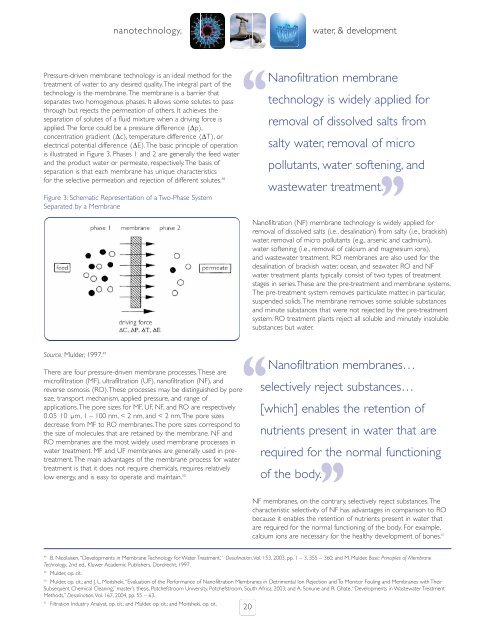Global Dialogue on Nanotechnology and the Poor ... - Nanowerk
Global Dialogue on Nanotechnology and the Poor ... - Nanowerk
Global Dialogue on Nanotechnology and the Poor ... - Nanowerk
You also want an ePaper? Increase the reach of your titles
YUMPU automatically turns print PDFs into web optimized ePapers that Google loves.
nanotechnology,<br />
water, & development<br />
‘‘<br />
Pressure-driven membrane technology is an ideal method for <strong>the</strong><br />
treatment of water to any desired quality.The integral part of <strong>the</strong><br />
technology is <strong>the</strong> membrane.The membrane is a barrier that<br />
separates two homogenous phases. It allows some solutes to pass<br />
through but rejects <strong>the</strong> permeati<strong>on</strong> of o<strong>the</strong>rs. It achieves <strong>the</strong><br />
separati<strong>on</strong> of solutes of a fluid mixture when a driving force is<br />
applied.The force could be a pressure difference (∆p),<br />
c<strong>on</strong>centrati<strong>on</strong> gradient (∆c), temperature difference (∆T), or<br />
electrical potential difference (∆E).The basic principle of operati<strong>on</strong><br />
is illustrated in Figure 3. Phases 1 <strong>and</strong> 2 are generally <strong>the</strong> feed water<br />
<strong>and</strong> <strong>the</strong> product water or permeate, respectively.The basis of<br />
separati<strong>on</strong> is that each membrane has unique characteristics<br />
for <strong>the</strong> selective permeati<strong>on</strong> <strong>and</strong> rejecti<strong>on</strong> of different solutes. 48<br />
Figure 3: Schematic Representati<strong>on</strong> of a Two-Phase System<br />
Separated by a Membrane<br />
Nanofiltrati<strong>on</strong> membrane<br />
technology is widely applied for<br />
removal of dissolved salts from<br />
salty water, removal of micro<br />
pollutants, water softening, <strong>and</strong><br />
’’<br />
wastewater treatment.<br />
Nanofiltrati<strong>on</strong> (NF) membrane technology is widely applied for<br />
removal of dissolved salts (i.e., desalinati<strong>on</strong>) from salty (i.e., brackish)<br />
water, removal of micro pollutants (e.g., arsenic <strong>and</strong> cadmium),<br />
water softening (i.e., removal of calcium <strong>and</strong> magnesium i<strong>on</strong>s),<br />
<strong>and</strong> wastewater treatment. RO membranes are also used for <strong>the</strong><br />
desalinati<strong>on</strong> of brackish water, ocean, <strong>and</strong> seawater. RO <strong>and</strong> NF<br />
water treatment plants typically c<strong>on</strong>sist of two types of treatment<br />
stages in series.These are <strong>the</strong> pre-treatment <strong>and</strong> membrane systems.<br />
The pre-treatment system removes particulate matter, in particular,<br />
suspended solids.The membrane removes some soluble substances<br />
<strong>and</strong> minute substances that were not rejected by <strong>the</strong> pre-treatment<br />
system. RO treatment plants reject all soluble <strong>and</strong> minutely insoluble<br />
substances but water.<br />
Source: Mulder, 1997. 49<br />
‘‘<br />
There are four pressure-driven membrane processes.These are<br />
microfiltrati<strong>on</strong> (MF), ultrafiltrati<strong>on</strong> (UF), nanofiltrati<strong>on</strong> (NF), <strong>and</strong><br />
reverse osmosis (RO).These processes may be distinguished by pore<br />
size, transport mechanism, applied pressure, <strong>and</strong> range of<br />
applicati<strong>on</strong>s.The pore sizes for MF, UF, NF, <strong>and</strong> RO are respectively<br />
0.05 10 µm, 1 – 100 nm, < 2 nm, <strong>and</strong> < 2 nm.The pore sizes<br />
decrease from MF to RO membranes.The pore sizes corresp<strong>on</strong>d to<br />
<strong>the</strong> size of molecules that are retained by <strong>the</strong> membrane. NF <strong>and</strong><br />
RO membranes are <strong>the</strong> most widely used membrane processes in<br />
water treatment. MF <strong>and</strong> UF membranes are generally used in pretreatment.The<br />
main advantages of <strong>the</strong> membrane process for water<br />
treatment is that it does not require chemicals, requires relatively<br />
low energy, <strong>and</strong> is easy to operate <strong>and</strong> maintain. 50<br />
Nanofiltrati<strong>on</strong> membranes…<br />
selectively reject substances…<br />
[which] enables <strong>the</strong> retenti<strong>on</strong> of<br />
nutrients present in water that are<br />
required for <strong>the</strong> normal functi<strong>on</strong>ing<br />
’’<br />
of <strong>the</strong> body.<br />
NF membranes, <strong>on</strong> <strong>the</strong> c<strong>on</strong>trary, selectively reject substances.The<br />
characteristic selectivity of NF has advantages in comparis<strong>on</strong> to RO<br />
because it enables <strong>the</strong> retenti<strong>on</strong> of nutrients present in water that<br />
are required for <strong>the</strong> normal functi<strong>on</strong>ing of <strong>the</strong> body. For example,<br />
calcium i<strong>on</strong>s are necessary for <strong>the</strong> healthy development of b<strong>on</strong>es. 51<br />
49<br />
B. Nicolaisen,“Developments in Membrane Technology for Water Treatment,” Desalinati<strong>on</strong>,Vol. 153, 2003, pp. 1 – 3, 355 – 360; <strong>and</strong> M. Mulder, Basic Principles of Membrane<br />
Technology, 2nd ed., Kluwer Academic Publishers, Dordrecht, 1997.<br />
49<br />
Mulder, op. cit.<br />
50<br />
Mulder, op. cit.; <strong>and</strong> J. L. Moitsheki,“Evaluati<strong>on</strong> of <strong>the</strong> Performance of Nanofiltrati<strong>on</strong> Membranes in Detrimental I<strong>on</strong> Rejecti<strong>on</strong> <strong>and</strong> To M<strong>on</strong>itor Fouling <strong>and</strong> Membranes with Their<br />
Subsequent Chemical Cleaning,” master’s <strong>the</strong>sis, Potchefstroom University, Potchefstroom, South Africa, 2003; <strong>and</strong> A. S<strong>on</strong>une <strong>and</strong> R. Ghate, “Developments in Wastewater Treatment<br />
Methods,” Desalinati<strong>on</strong>,Vol. 167, 2004, pp. 55 – 63.<br />
51<br />
Filtrati<strong>on</strong> Industry Analyst, op. cit.; <strong>and</strong> Mulder, op. cit.; <strong>and</strong> Moitsheki, op. cit.<br />
20
















